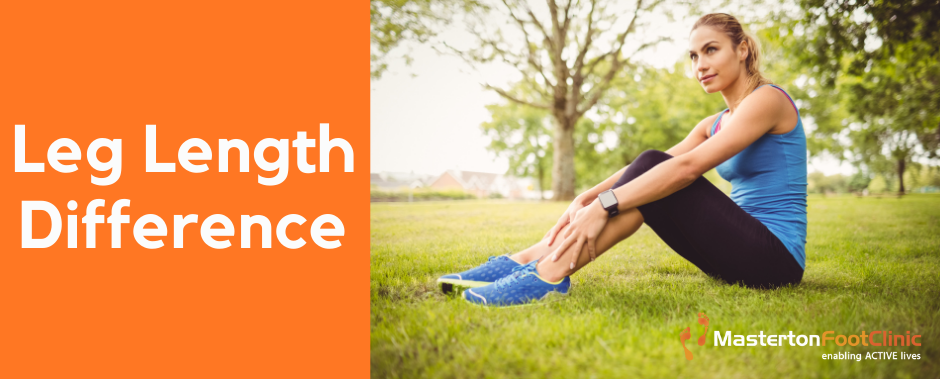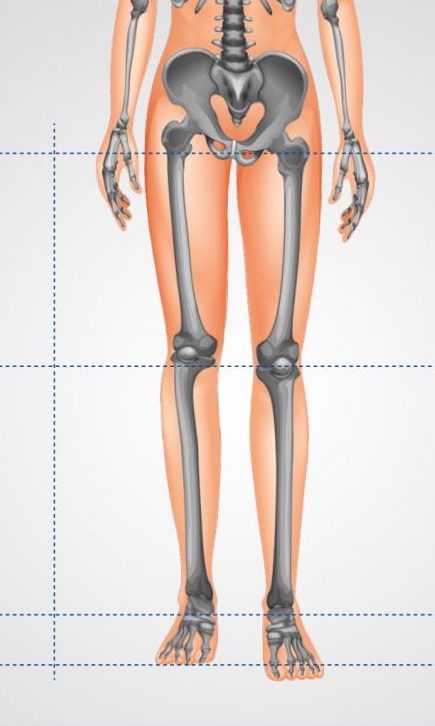
Up to 90% of people have slight leg length differences – an average of about 5mm. Just like differences in the size of our feet, this can be a normal difference that doesn’t cause any pain for many people. For others, however, their leg length difference can make it painful to walk and complete activities around the house, let alone playing sports or staying physically active.
When you have pain in your feet, legs, knees or hips, leg length differences are one of the things our podiatrists check for and assess. This is very important as a significant leg length difference can have serious consequences – such as a tilt in the hips which can then overload, stress and strain joints and cause imbalances through the feet, legs and spine.
What causes a leg length difference?
 To understand the causes, it’s important to know that there are two types of leg length differences – structural and functional.
To understand the causes, it’s important to know that there are two types of leg length differences – structural and functional.
Structural differences refer to a difference between the length of one or more bones, typically the thigh bone (femur) or the shin bone (tibia). These differences may be due to the natural shapes of the bones, as a result of an injury, surgery or disease.
Functional differences occur when the length of the bones are structurally the same (or close enough to the same to not cause any problems), but the way your joints, muscles and ligaments work together as you stand and walk means a difference is created. Picture this: you have one foot with a normal arch and one that rolls in quite a bit to have a flat arch. This may create a functional leg length difference when you stand, tilting one hip further down on the flatter foot, even though the measurable length of the bones is the same.
The functional differences we see are often the result of contracted muscles, often at the hips, where one side is tighter than the other. The same can occur when ligaments on one side of the hips or lower limbs are looser, or when a tendon on one side isn’t working quite right. For some of our patients, neurological diseases cause their muscle contracture and their leg length differences.
Leg length difference: How much is too much?
This is a hard one to answer precisely as this changes from person to person. We’ve seen patients with differences that we’ve measured at 12-15mm and have no symptoms, and others that are getting knee pain or other problems. The reason for this difference is because bodies compensate differently for a leg length difference. Some can naturally adapt to a slight difference easily, while others may compensate in a way that overuses joints or muscles and may result in pain.
Generally speaking, studies show that differences of over 20mm are significant enough to lead to pain or other symptoms starting.
How do I know if I have a leg length difference?
When patients come to us with certain types of hip and leg pain, one of the first things we look for is an imbalance in the position of your knees, hips and ankles relative to one another. If present, this is a big sign that a leg length difference may contribute to your symptoms. Looking at your gait is also a good way to see what’s happening with your lower limbs and if a difference may be present. Other signs include:
- Limping or hitching your hip while walking – this can occur when you want to help the longer leg clear the ground
- Uneven steps – shorter steps on the shorter leg
- Uneven pressures distributed between the feet on a pressure mat
- Uneven wear patterns between the two shoes – one shoe wears down faster than the other, which may also exacerbate the difference
- Pain in the hips, knees or back
- Stress fractures or other problems that don’t appear to have a traditional cause
How to treat a leg length difference?
Treating a leg length difference starts by understanding the cause of the difference. In some cases, where muscle contracture is the cause, we can help relax the muscle and get it back to a healthy state through care like mobilisation therapy or stretching programs. If the difference is a result of different positioning or function of your feet, we may use orthotics to evenly support the feet and promote symmetrical movement.
If a leg length difference is structural, like when one leg ends up shorter than the other after a surgery like a hip or knee replacement, then it’s important to have a ‘raise’ of some sort to bring the shorter foot in contact with the ground at the same level as the longer foot. Masterton foot clinic is unique as we can modify your shoes to add an in-built heel raise to the outer sole to correct your leg length difference. We can also build up your orthotics to achieve a similar function.
Simply put: we have Wairarapa’s widest variety of the best treatment options to suit the cause of your leg length difference. As with any foot problem, it’s vital to understand what’s causing the difference – and its exact size, to implement the best care and gain the best results both now in the short term and for the years to come.
If you suspect that you have a leg length difference or are battling foot or leg pain that won’t go away and you’re not sure why, book your appointment with us by calling 06 370 4057 or book online.
Frequently Asked Questions
How common is a leg length difference?
Minor LLD is relatively common, with many people having a slight discrepancy in leg length. Clinically significant LLD, where the difference is noticeable and causes symptoms, is less common but still occurs in a significant portion of the population.
How is leg length difference diagnosed?
Diagnosing a limb length difference involves a physical exam with your podiatrist. CT or bone scans may be used to measure the precise difference in leg length and help determine its cause.
Are there exercises to help with leg length difference?
Physical therapy and specific exercises may help improve muscle strength, balance, and posture, which can alleviate some of the symptoms associated with LLD. However, they may not correct the actual difference in leg length.
Can a leg length difference lead to other health problems?
Yes, an untreated LLD can lead to various health issues, including musculoskeletal problems, joint pain, and an increased risk of injuries due to abnormal gait and posture.
Is it possible to prevent a leg length difference?
In some cases, LLD may be prevented if it results from avoidable factors such as injuries or certain developmental issues. However, congenital and genetic causes may not be preventable.
